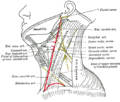| Great auricular nerve | |
|---|---|
 | |
 Plan of the cervical plexus. (Great auricular labeled at top center.) | |
| Details | |
| From | Cervical plexus (C2-C3) |
| Innervates | Sensation of inferior part of auricle and parotid region of the face |
| Identifiers | |
| Latin | nervus auricularis magnus |
| TA98 | A14.2.02.018 |
| TA2 | 6385 |
| FMA | 6872 |
| Anatomical terms of neuroanatomy | |
The great auricular nerve is a cutaneous (sensory) nerve of the head. It originates from the second and third cervical (spinal) nerves (C2-C3) of the cervical plexus. It provides sensory innervation to the skin over the parotid gland and the mastoid process, parts of the outer ear, and to the parotid gland and its fascia.
Contents
- Structure
- Origin
- Course and relations
- Branches
- Distribution
- Clinical significance
- Additional images
- References
- External links
Pain resulting from parotitis is caused by an impingement on the great auricular nerve.

